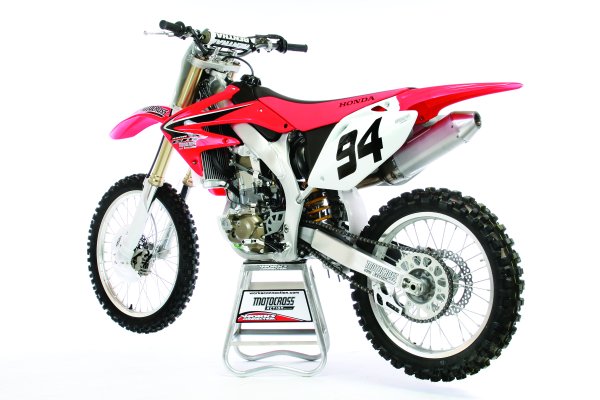MOTOCROSS ACTION’S TWO-STROKE VERSUS FOUR-STROKE SHOOTOUT: 2004 CRF450 VERSUS 2001 CR500

First, let’s get one myth out of the way up front. It is common for modern critics of the 450cc four-stroke to claim that the AMA 500cc National Championship was terminated because bikes like the CR500 and KX500 were too powerful. Not true. Not even close to true. The reality is that the AMA dropped the 500 National Championships after the 1993 season under political pressure from Suzuki and Yamaha. No surprise there; neither Suzuki nor Yamaha built a competitive 500cc motocross bike. In fact, Suzuki hadn’t put a rider in the top ten of the 500 Nationals since 1982. Based on simple economics, Suzuki had no interest in the AMA holding a championship for a bike they didn’t make. Yamaha hadn’t done much better, making one final futile attempt in 1991 when they put Damon Bradshaw and Doug Dubach on the overweight, enduro-based, air-cooled WR500 washing machines.
Surprisingly, AMA Pro rider turnouts at 500 Nationals were greater than the turnout for 250 Nationals. Privateers like Lance Smail, Mike Fisher, Dag Boyesen, Cliff Palmer, Ray Sommo, Brian Manley, Rich Taylor, Gene Naumec, Fred Andrews and Kurt McMillan knew that the power of a box-stock 500cc two-stroke closed the performance gap between production bikes and works bikes (unlike in the 125 and 250 classes). Lots of power was the great equalizer…proven by the fact that six of the top ten in the 1993 500 Nationals were privateers. That never happens today!
The 500 class died, was killed, or was pushed off a cliff in 1993. The culprit might have been politics, but it was a fait accompli nonetheless.
Flash forward 15 years, and suddenly the drum beats are sounding about how the 450cc four-strokes are too powerful. And, like the 500 class demotion that came before, the AMA politicos think that the 450s should be eliminated also. The AMA’s suggested 350cc solution is unproven theory put forth with no testing, study or scientific foundation. Does anyone think that a 13,500 rpm 350cc four-stroke will be slower than an 11,000 rpm 450cc four-stroke? If you do, you are more naive than Steve Whitelock. The 350 will not only be faster, but it will be more expensive to maintain, hop-up and race. A 350cc four-stroke is not the great equalizer. Not by a long shot.
Which leads the MXA wrecking crew to a logical shootout. What if we took a brand-new 2001 Honda CR500 and compared it to a brand-new 2008 Honda CRF450? Actually, that is misleading, because it sounds like we are testing a six-year-old bike against a brand-new one. Not true. The MXA wrecking crew is actually testing a 15-year-old bike against a brand-new CRF450. How so? Although our CR500 was produced in 2001, it was based on the 1992 CR500 (and only saw modest gearing, suspension and graphics mods during its ten-year life span).
Yes, we know that it isn’t a fair shootout to compare a bike designed in the early ’90s against a bike designed in 2004 (and modified at the factory three times since then), but we are going to do it anyway.
Our methodology was simple. We signed up four test riders to spend time on our sparkling-new 2001 CR500 and showroom-fresh 2008 CRF450. Three of the test riders were used for lap time testing only. They were given a whole day to acclimate themselves to both the CR500 and the 2008 CRF450. At the end of the day, the three riders (a Junior, Intermediate and AMA Pro) were sent out to do lap times on both bikes. The second portion of the test was to take a single pro rider, one who had spent several years racing a CR500, and have him race both bikes (splitting motos on MXA’s 2001 CR500 and his own 2007 CRF450). We weighted the results of the four test riders, favoring our CR500 hired gun, but still taking the whole testing procedure into account.

Q: WHICH ONE MAKES THE MOST POWER?
A: Stock for stock there is no comparison?the CR500 two-stroke pumps out approximately 55 horsepower, to the 50 horsepower of the CRF450. If you doubt those numbers, you will be convinced by turning the throttle wide open on both bikes. The CR500 explodes, while the CRF450 churns its way forward.
In a test of sheer power, the CR500 wins. Unfortunately for the CR500, the only way to make all that power controllable is to tame it (which Honda did in later years by gearing the bikes taller) or turn it on with caution. The CRF450 doesn’t require as much care. It makes more power off the bottom and on the top than the CR500. And, it does it all in a manageable, torquey manner. The CRF450 is Dr. Jekyll. The CR500 is Mr. Hyde.
Q: WHICH ONE IS THE FASTEST?
A: First and foremost, our concept of faster is gauged by the ability to ride the bike faster?not just hang on and pray. The CRF450 turned faster lap times because it has a controllable delivery. It was less violent under acceleration and less chuggy under deceleration. The versatility of the four-stroke outweighs its shortcomings at peak horsepower. No contest.
But, and this is a big but, if you have the skill to pull the trigger, the CR500 would actually gobble the CRF450 up in deep loam, rough straights and steep hills. The big two-stroke was a rocketship when it had a rocket man at the controls.
Q: WHICH ONE IS EASIER TO RIDE?
A: The idea of easy-to-ride can’t even be applied to the CR500. It is a workout to hang on to it. When you build up the bravery or get it up to speed, things start to smooth out, but it takes talent, nerves and skill to leave it on. This category is all about the CRF450.
Q: HOW DO YOU RIDE A CR500?
A: At most tracks, you can start in third gear and leave the bike there for almost the entire moto. A CR500 rider doesn’t have to do very much shifting, except to get through the pits and to break through the sound barrier. Clutch action is limited to pulling it in when you overshoot corners (because you misjudged the speed you were traveling). In many ways, the CR500’s ability to run in only one of its five speeds allows the rider to concentrate on picking lines and grabbing big handfuls of brake.

Q: AND THE POWERBAND WINNER IS?
A: Need you ask? The CRF450 wins the overall powerband category.
Q: WHICH BIKE HAS THE BEST SUSPENSION?
A: From 1992 on, Honda made very few changes to the CR500 package, but one area where they did try to keep up to date was with the suspension components. Unfortunately, the MXA test crew didn’t like the forks on the late model CR500s (post 1996). They worked best at low speed or with light riders. If you pushed them, they bottomed over big jumps. Back in the day, we swapped the stock 0.42 kg/mm fork springs for stiffer 0.43s, but in this stock-to-stock shootout we didn’t have that option.
On the 2008 CRF450, Honda had upped the stock spring rates over what was used in the 2007 model. The addition of 0.47 kg/mm fork springs made the CRF450 much more capable of grabbing big air. But, when it came time to race the two bikes, the CR500 wasn’t as outdated on the track as it was on the calendar. The suspension was fairly usable. We think the CRF450 suspension was better, but were shocked that it wasn’t a slam-dunk victory.
Q: WHICH BIKE WEIGHS THE LEAST?
A: The Honda CRF450 was the lightest. At 232 pounds, it weighs 15 pounds less than the CR500.
Q: WHICH BIKE IS THE LOUDEST?
A: No contest. The CR500 is whisper quiet. In a race, the spectators couldn’t hear the CR500’s two-stroke engine over the CRF450’s growl.
Q: WHICH BIKE HANDLES THE BEST?
A: No mystery here. A bike that weighs 15 pounds less, produces a broad, torquey powerband and has modern suspension is no match for a heavy, powerful bike with old-school suspension balance. The CRF450 has a leg-up in this category based on eras, age and modern sensibilities.
Q: AND NOW FOR THE $64,000 QUESTION…
A: When asked to choose between the 2001 Honda CR450 and the 2008 Honda CRF450, the three lap-time test riders unanimously chose the modern four-stroke. Since they had limited CR500 experience (and one of the three had never ridden an Open class two-stroke before), we expected them to be more at home on the CRF450. Lap time test results were interesting. The Junior-level rider was only one second a lap faster on the CRF450 than on the CR500. The Intermediate was five seconds a lap faster on the CRF450, while the AMA pro was six seconds a lap faster on the CRF450. We were surprised that the lower the skill level of the rider, the lower the lap time difference, but not as surprised as by our race test. Within three or four laps, our CR500-savvy racer was cranking out competitive lap times. By the time the race rolled around, he began to like the CR500. And when he would switch back to his CRF450, he’d say that “it felt weird to ride the four-stroke.”
In the end, our pro racer came to a convoluted conclusion. If the CR500 engine was placed in the lighter, better suspensed and more modern CRF450 chassis, he’d prefer to race the CR500. For our purposes, the frame swap was not possible, and we had to judge the 2001 CR500 with its old-fashioned feel. Its sofa saddle, pulled-back bars, bulbous gas tank and bulky ergos were part of the total package. If we could lose all of that?and make a modern version of the CR500?it would be competitive.
Q: AND THE WINNER IS…
A: As the two bikes sit, the 2008 CRF450 is a much better race bike than the 2001 CR500. You don’t have to be Sherlock Holmes to figure that out?but even Dr. Watson would be surprised that the margin of victory wasn’t as great as everyone expected.






Comments are closed.